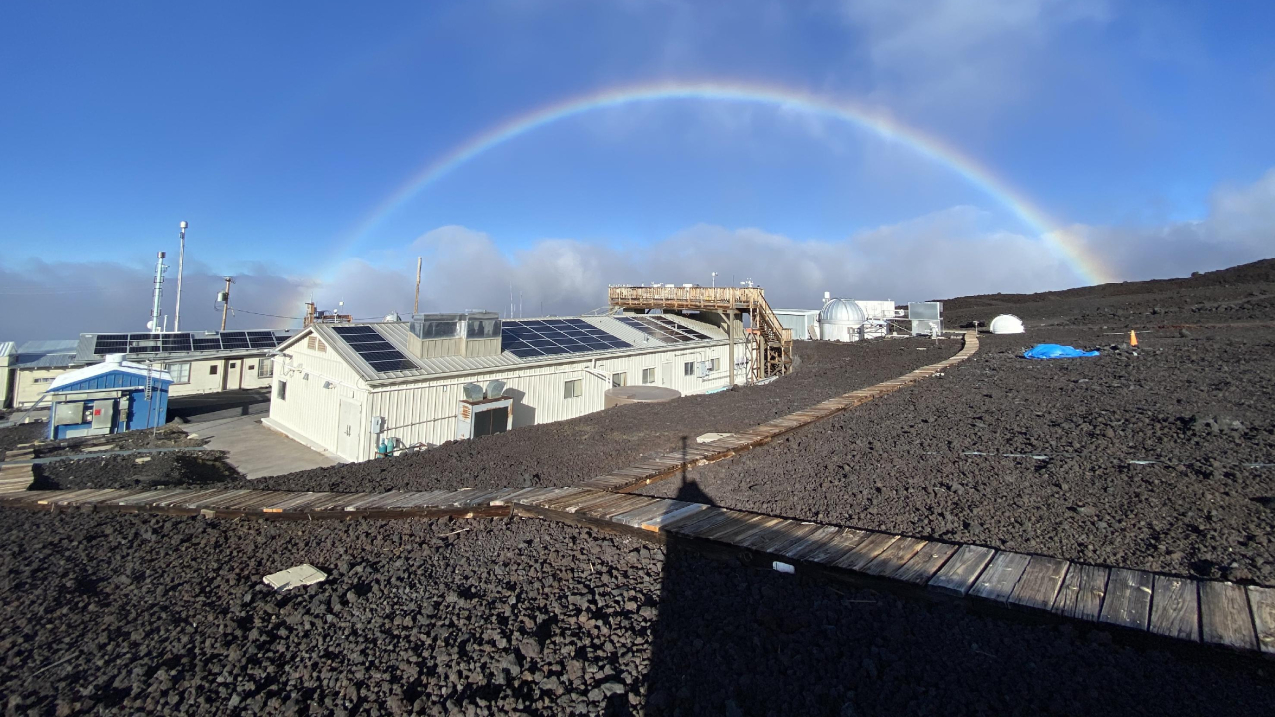NOAA, NASA, NIST and EPA to lead government effort

Rainbow over NOAA's Mauna Loa Observatory on the Big Island of Hawaii. The observatory is a premier atmospheric research facility that has been continuously monitoring and collecting data related to atmospheric change since the 1950s. (Image credit: Brian Vasel/NOAA)
Today, the Biden-Harris Administration released a conceptual framework for a national system to measure, monitor and share information related to reducing greenhouse gas emissions in order to meet U.S. commitments under the 2015 Paris Agreement offsite link.
Led by the White House Office of Management and Budget, Office of Science and Technology Policy, and Climate Policy Office, the new U.S. Greenhouse Gas Measurement, Monitoring, and Information System strategy builds on a wide array of cooperative research, data products, activities and capabilities aimed at understanding emissions, removals and sinks of greenhouse gases (GHGs) from national to regional and urban scales as well as from a range of sources.
NOAA will commit its long-established, state-of-the-art capabilities in observation, modeling and data analysis, including the Global Greenhouse Gas Reference Network, Carbon Tracker, HYSPLIT dispersion model and satellite remote sensors, to support this whole-of-government effort.
“NOAA’s more than 50 years of measuring and monitoring greenhouse gas emissions around the globe provide a solid foundation for this new national effort to better understand the main driver of climate change,” said NOAA Administrator Rick Spinrad, PhD. “Our contributions reflect NOAA’s critical role in observing, predicting and sharing this knowledge with communities to help them build resilience to the effects of climate change.”
Measuring greenhouse gases is a complex challenge
Identifying and quantifying emissions of the major greenhouse gases — carbon dioxide (CO2), methane (CH4) and nitrous oxide (N2O) — emitted by human activity as well as terrestrial and aquatic landscapes, is a complex challenge that requires direct and indirect measurements, modeling efforts and collection of data across a variety of sectors and systems. Some sources, such as fossil fuel CO2 emissions, can be estimated with high accuracy. Sources of methane emissions, which range from fossil fuel use, to agriculture, livestock, landfills and wetlands, are more variable and make estimates challenging.
NOAA is a leading international authority on atmospheric and oceanic in situ GHG measurements. NOAA’s observational networks range from global to regional to local, and include ground-based, tower-based, and airborne measurements of atmospheric GHGs, as well as surface and subsurface ocean carbon measurements from ships, buoys and other autonomous platforms.
NOAA and the National Institute of Standards and Technology (NIST) have played a critical role in standards development and calibration of GHG sensors, benefiting domestic and international GHG monitoring and measurement efforts. NOAA satellites monitor global GHG concentrations in the free troposphere. When combined with in situ observations and models such as CarbonTracker, they advance the understanding of GHG fluxes and sinks. For monitoring facility-level leaks of methane, NOAA is working with NASA's Commercial SmallSat Data Acquisition Program to develop and demonstrate operational capabilities.
Sarah Kapnick, Ph.D., NOAA’s chief scientist, said the national strategy is important for mitigating the effects of climate change, and for capitalizing on the opportunities that will be presented by the shift to a clean energy economy. "The path laid out today — maximizing the sustained observations and monitoring that are already underway while we work together to develop improved tools in the future — will strengthen our understanding of the carbon cycle, support the national economy and help us achieve our climate goals," Kapnick said.
Phase One goals identified
One of the initial goals identified in the national strategy is the development of prototype urban-scale operational GHG monitoring systems led by NOAA and NIST covering the Washington, D.C.-Baltimore and Indianapolis metro regions. The prototypes will combine “top-down” atmospheric measurements with “bottom-up” emissions inventories for whole and sub-city emissions. It will integrate existing surface and regional networks with airborne data collection and activity-based, fossil fuel CO2 and methane emissions data systems with new and expanded observing capabilities. Work on an operational urban-scale GHG monitoring system in the D.C.-Baltimore region is already underway using existing assets.
Typically emissions estimates are posted only once a year. The new approach will increase that to biannual or quarterly updates, which will help regional and local planners and federal agencies monitor and verify their GHG emissions mitigation plans. Lessons learned from the prototype will help subsequent efforts to scale up the information system, as well as shape more useful GHG emissions information products and modeling of emissions from urban areas.
The national strategy also calls for the development of a virtual U.S. Greenhouse Gas Center to better coordinate the nation’s GHG information delivery and stakeholder engagement. The center, initially led by NASA, NIST, NOAA and the Environmental Protection Agency, will compile greenhouse gas data from observations and models in an interactive site that can be used to enhance coordination and facilitate GHG data and modeling capabilities among federal agencies, international partners and commercial providers.
This initial two-year demonstration phase creates a way to explore and analyze U.S. government and other datasets, focusing on three areas of greenhouse gas research : human-caused GHG emissions, natural GHG sources and sinks and methane emission leaks from large events.
In addition, demonstration efforts will target opportunities to gather more GHG information from agricultural activities, energy, waste and natural systems. Some of the efforts will focus on methane detection and quantification, recognizing significant demand and opportunities at the state and federal levels to mitigate methane emissions consistent with the U.S. Methane Emissions Reduction Action Plan.
To learn more about the U.S. Greenhouse Gas Measurement, Monitoring Information System Strategy online.
Media contact
Theo Stein, NOAA Communications, theo.stein@noaa.gov, (303) 819-7409



